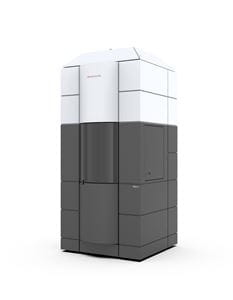A six-member research consortium, including Indiana University School of Medicine and IU Bloomington, is bringing a new state-of-the-art cryo-electron microscopy platform to the state of Indiana.
The Titan Krios lets scientists look at how proteins and viruses are built atom by atom. It also produces 3D images of those structures and can even identify new proteins that are currently unrecognizable. The microscope works through a new technology known as micro-electron diffraction.
Most medicines are designed to target proteins in the body that are part of the disease process — for example, tumor cells in cancer or brain proteins in Alzheimer’s disease — and this new cryo-EM allows researchers to actually see these protein structures. A recent scientific breakthrough by IU School of Medicine researchers uncovered that the tau protein structure involved in chronic traumatic encephalopathy is actually different from the tau protein structure involved in Alzheimer’s disease, but only after using cryo-EM capabilities based in Cambridge, England.
Access to this new cryo-EM platform will aid the chemical biology and biotherapeutics scientific pillar of the IU Precision Health Initiative Grand Challenge by speeding up the cycle from basic discovery to clinical benefits.
“Cryo-EM provides an unprecedented ability to visualize the molecular machines that enable our cells to function and communicate,” said Distinguished Professor Michael Weiss, MD, PhD, MBA, chair of the Department of Biochemistry and Molecular Biology at IU School of Medicine and leader of the chemical biology and biotherapeutics scientific pillar. “This promises to advance fundamental understanding of diverse diseases from cancer and diabetes to viral infections and Alzheimer’s disease. What’s more, these images can inform how to design new drugs to prevent and cure these diseases.”
Indiana University already has one cryo-EM based in Bloomington, but advancements in the technology made this acquisition necessary.
“This is more sophisticated technology and a top-of-the-range instrument necessary to achieve our bold goals of preventing and curing dreaded diseases,” said Carmel Egan, PhD, operations director for the Precision Health Initiative, associate dean for research affairs at IU School of Medicine and chief operating officer for the Indiana Clinical and Translational Sciences Institute.
Accessibility of the new cryo-EM platform will also be a great recruitment tool for scientists to Indiana.
“This collaboration is a superior example of the kind of statewide impact that can be made through shared vision and resources,” said Anantha Shekhar, MD, PhD, executive associate dean for research affairs at the IU School of Medicine and founding director of the Indiana CTSI. “Bringing an expanded cryo-EM platform to Indiana makes the state more competitive in attracting scientists, by giving them access to cutting-edge technology and tools that enable scientific breakthroughs. We are grateful for the INCITE program, supported by Lilly Endowment, for making this collaboration possible.”
Through the consortium, researchers are guaranteed use of the Titan Krios. The platform will be housed at Purdue University, where an education and training program is available for all consortium users. Cryo-EM is considered such an important tool to scientific discovery that its creators received a 2017 Nobel Prize in Chemistry.




